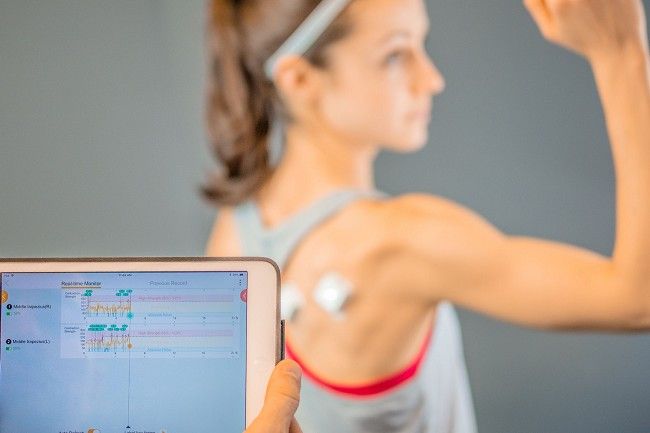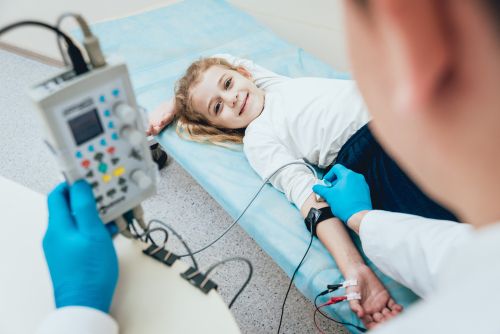 Written by Megan Smith, PT
Written by Megan Smith, PT
EMG or electromyography systems have been gaining popularity in recent years for use in both athletics and physical rehabilitation.
That’s because the entire purpose of electromyography is to measure and record the electrical activity and output of various muscle groups. This can be great to measure performance for athletes, but it is also an excellent way for therapists to diagnose injuries and to help patients track their rehabilitation progress.
So how exactly do EMG systems work?
First, either electrodes are adhered to the skin over the area of the muscle that will be measured, or a needle is inserted into the bulk of the muscle tissue to be measured.
Then, the electrodes measure bioelectric feedback in the muscles and transmit that information to the readout device that shows the muscle activity in an easy-to-read graph.
By tracking the nerve impulses and muscular activity of the wearer, EMG systems are able to provide valuable clinical data that can be crucial in the process of rehabilitation or exercise.
Because of their value to healthcare facilities, rehabilitation and physical therapy clinics, and athletic trainers’ offices, EMG systems are extremely popular.
But, how do you know which EMG system will be the most functional for your patient, your clinic, or your specific needs?
We’ve put our collective 40 years of medical experience to the test, compiling all the information you could ever want or need in one convenient place. All you have to do is take it in.

Electromyography measures the electrical activity in muscle tissue. Often, they are used to diagnose various conditions or injuries, or used to measure the strength output of various systems in athletic training.
Do not drink or eat foods containing caffeine for two to three hours before an EMG reading, and don’t smoke for at least two or three hours prior to your EMG.
In case your doctor has any specific recommendations, however, it’s important to speak with them about what their requirements are for you before performing an EMG test.
EMG tests are relatively simple and easy, but there are two options for readings. Either, EMG electrodes will be adhered to your skin, this is a surface EMG, or a needle will be inserted into the body of the muscle to read the electrical activity deeper within the tissue.
 Choosing an EMG System
Choosing an EMG System
While perhaps an obvious point, the most important consideration when looking into an EMG system is how you’re going to use it.
This point is so crucial because not all EMG devices are designed solely for the purpose of providing electromyography data. Instead, many products include EMG capabilities for the purpose of tracking treatments or specific conditions.
For example, for patients with dysphagia—a condition characterized by having difficulty swallowing—the use of neuromuscular stimulation (NMES) devices helps to promote healthy, comfortable swallowing. However, these devices are very commonly paired with EMG systems to track the activity caused by the NMES treatment in real-time.
A good example of this can be seen in the VitalStim Plus NMES and sEMG system from Chattanooga. The device provides the muscular stimulation therapy that helps assist patients with dysphagia, while also using a built-in EMG system to track the muscular activity resulting from the treatment.
Because not all EMG systems are designed solely for the purpose of electromyography, it is vitally important that you review the intended uses of an EMG system before making a purchase. This can save you time, frustration, and money.
Even among the EMG systems designed for only electromyography, there are important differences between products, depending on their designed usage.
For example, there are distinct differences between EMG systems that are designed for rehabilitation or physical therapy as compared to those for athletic activity.
One of the most noticeable differences between EMG systems designed for high intensity athletic activity as compared to lower intensity rehabilitation exercise is the size of the design and the style of EMG, whether surface or intramuscular.
For athletes, EMG systems feature very small, lightweight, and unobtrusive electrodes for tracking surface electromyography. These products are usually very popular among athletes, who are undergoing high intensity activity and cannot have the EMG system getting in their way.
On the other hand, for patients who are working in lower intensity, rehabilitative capacities, the enhanced grip and lightweight design of athletic EMG systems—which can often be more expensive—is not entirely necessary.
Another important feature to consider when purchasing an EMG system is the way that each product delivers its biofeedback.
For many products, the data gathered from the system’s electrodes is delivered on a handheld monitor. However, some EMG systems operate by delivering their biofeedback directly to the user’s smartphone via an app.
Given that not all EMG users necessarily have smartphones with which to use an EMG app, it is important to consider how each product provides its data before making a purchase.
It is also important to consider how the data is presented (beyond just the platform upon which it is presented).
Different EMG systems present their data in different ways—most products offer tutorial videos to familiarize you with how to read the information as it comes in.
Depending on your preferences and taste, certain products’ presentation of data may feel more user-friendly than others. With this in mind, it is worth checking how a product’s data is presented before making a purchase.
With products like EMG systems, the ability to reuse the equipment efficiently is a valuable feature. The key component of reusability for most EMG systems comes in regards to the system’s electrode adaptors.
For intramuscular EMGs, obviously, the needles will not be reused, but for surface EMGs, the reusability of the electrodes is a major consideration.
Depending on the frequency with which you plan to use your EMG system and the number of users that will use it, having a large supply of additional electrode adaptors can be essential for hygiene purposes.
However, if you’ll be using the EMG for yourself, or just for one patient, then reusable electrodes can save you a lot of time and money.
Most EMG systems operate using battery power—either through a rechargeable internal battery or using replaceable batteries.
Almost every battery-powered EMG system will mention a rough estimate of the system’s battery life, and this is an important consideration, along with whether it will need to be charged, or you will have to replace the batteries.
Depending on how long you’ll need to use your device per session and your preference in charging versus replacing batteries, you may find that certain devices are a better fit for your needs.
Beyond the features discussed above, there is a bevy of additional or optional features offered with some EMG systems that are worth considering.
Some examples of these optional features include utility items like easy-to-pack carrying cases and convenience items like back-up battery packs to ensure a full charge is always available.
Other systems may also include app support for operation through either a tablet or a smartphone, or wireless designs that make wearing them during activity totally simple.

EMG systems provide the invaluable ability for healthcare professionals to track the electrical activity of muscle tissue and use that data to help in diagnosing and/or treating a plethora of injuries, diseases, and disorders.
Hopefully, you found what you were looking for. If not, let us know how we could improve! Or, check out the rest of our helpful articles on Caregiver University for the best caregiving tips and tricks online.

Megan has been a part of Rehabmart since its inception nearly 20 years ago. For the past several years she has been enjoying her role as HR Director while maintaining her Physical Therapy license. When she isn't working on her next in-service or working to find a new team member, she enjoys her five children, helping those who have PT type ailments, baking, practicing yoga, and working out.